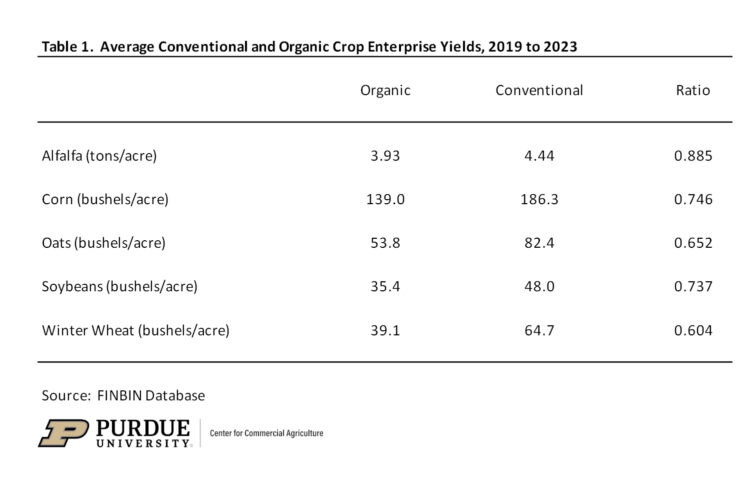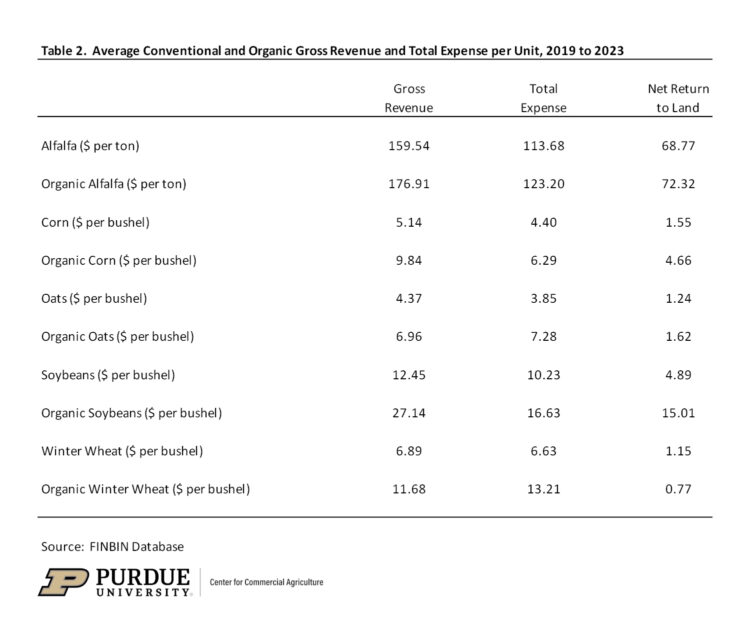July 12, 2024
Conventional & Organic Enterprise Net Returns, FINBIN data from 2019 to 2023
by Michael Langemeier
Information pertaining to the relative profitability of conventional and organic production is often lacking. A previous article compared net returns for conventional and organic crop enterprises using FINBIN data from 2018 to 2022 (Langemeier, 2023). This article uses FINBIN data from 2019 to 2023 to update comparisons of crop yields, gross revenue, total expense, and net returns for conventional and organic alfalfa, corn, oats, soybeans, and winter wheat. The organic enterprise data represents farms that have already transitioned to organic production, and thus, do not include information pertaining to the transition phase.
Crop Yields
Table 1 shows the average conventional and organic crop yields for alfalfa, corn, oats, soybeans, and winter wheat. The ratio illustrated in the last column of the table was computed by dividing the organic crop yield by the conventional crop yield. Alfalfa exhibited the smallest difference in crop yields (12 percent) between conventional and organic crops. The yield drags for corn, oats, soybeans, and winter wheat were 25 percent, 35 percent, 26 percent, and 40 percent, respectively.
Gross Revenue, Total Expense, and Net Return to Land
Gross revenue, total expense, and net return to land per unit (per acre) for alfalfa, corn, oats, soybeans, and winter wheat are presented in table 2 (table 3). Gross revenue includes crop revenue, crop insurance indemnity payments, government payments, and miscellaneous income. Total expenses include all cash and opportunity costs, other than those associated with owned farmland. Farmland costs included in the total expense reported in table 2 and table 3 were comprised of cash rent, real estate taxes, and interest, which would be lower than the full opportunity cost on owned land. Just to give the reader some idea as to how large this excluded cost may be, you would need to add an estimated $0.28 per bushel ($0.94 per bushel) to the total expense for conventional corn (conventional soybeans) if you wanted to account for the full opportunity cost on owned land. Also, note that the per unit and per acre net returns presented in table 2 and table 3 represent a net return to land rather than an economic profit.
Though conventional and organic crops face different market phenomena, it is common to compare conventional and organic gross revenue per unit and crop prices, and net return to land on a per acre basis. Comparing organic to conventional gross revenue per unit reported in table 2, the smallest ratio of organic to conventional gross revenue per unit was for alfalfa (1.11) and the largest ratio (2.18) was for soybeans. Organic oats and winter wheat gross revenue per unit were 1.59 and 1.70 times their conventional counterparts, while the organic corn gross revenue per unit was approximately 1.91 times higher than the conventional corn gross revenue per unit. The gross revenue per unit ratios reported in table 2 represent five-year averages. The gross revenue per unit and crop price ratios for individual crops vary from year to year. For example, during the 2019 to 2023 period, the corn price ratio ranged from 1.67 in 2022 to 2.35 in 2019, and soybean price ratio ranged from 1.79 in 2023 to 2.36 in 2021.
It is important to note that the net returns reported in table 2 are on a per-unit basis. Given the differences in crop yields between conventional and organic crops, it is often more relevant to examine differences in per acre net returns than per-unit net returns. The average difference in net returns to land between the organic and conventional crops was $115 per acre. The largest difference was $359 per acre for corn. The difference for soybeans was $296 per acre. The differences for alfalfa, oats, and winter wheat were -$21, -$15, and -$44 per acre, respectively, indicating that the conventional alfalfa, oats, and winter wheat enterprises were more profitable than organic alfalfa, oats, and winter wheat. The lack of profits for the organic small grains and forages has important implications for organic crop rotations. Most organic crop rotations include a small grain or a forage such as alfalfa in the rotation. Market opportunities for organic small grains and forages vary substantially by region, and it can be difficult to find markets for these crops.
Difference in Net Returns Among Farms
The results above focus on differences in average net return to land. Economists have long pointed out the large differences in financial performance among farms. To account for the differences among farms, we used the FINBIN database to examine net returns for conventional and organic corn and soybean enterprises.
Figure 1 presents the comparisons among enterprise deciles (ten equal groups) for conventional and organic corn using 2019 to 2023 FINBIN data. Net return in this figure was computed by subtracting land expenses from net return to land, and excluded government payments, operator labor, and a management charge. The median net returns per acre for conventional corn and organic corn were $157 and $503, respectively. The difference in net return per acre for the bottom and top deciles was $787 for conventional corn and $1,252 for organic corn. Despite the larger median net return, it is important to note that there were quite a few organic farms with lower net returns for corn than their conventional counterparts in the top deciles.
Comparisons among enterprise deciles for conventional and organic soybeans are presented in figure 2. The median net returns using FINBIN data for the 2019 to 2023 period for conventional soybeans and organic soybeans were $126 and $419, respectively. The difference in net return per acre for the bottom and top deciles was $530 for conventional soybeans and $1,036 organic soybeans. Even though the median net return for organic soybeans is higher than the median net return for conventional soybeans, the organic producers in the lowest decile had net returns that were very similar to those for conventional soybean producers in the lowest decile.
What can we make of the results in figures 1 and 2? First, there is a larger difference in net returns between the organic producers than there is between the conventional producers. This result could be due to learning effects or the more complicated rotations associated with organic crop production. Second, obtaining a boost in net returns from organic soybean production appears to be much more difficult than it is for organic corn. This could be due to weed control issues often encountered when producing organic soybeans. The results in figures 1 and 2 stress the importance of examining the sensitivity of budgeted net returns for organic crops to changes in price, yield, and cost assumptions before transitioning acres.
Summary and Conclusions
This article compared crop yields, gross revenue, total expense, and net returns for conventional and organic corn and soybeans. FINBIN data (Center for Farm Financial Management, 2024) were used to make the comparisons in this article. Consistent with previous work, organic corn and soybean enterprises had lower crop yields, higher crop prices and gross revenue, and higher net returns. However, there was a much wider difference in enterprise net returns among organic corn and soybean enterprises than there was among conventional corn and soybean enterprises. It is also important to note that on average alfalfa, oats, and winter wheat grown conventionally had higher net returns than alfalfa, oats, and winter wheat grown using an organic cropping system.
This article summarized net returns for conventional and organic crop enterprises. It did not examine net returns during the transition period nor account for the fact that unlike many conventional rotations, organic crop rotations tend to include small grains and/or forages. Thus, it is very important to not just compare net returns for corn and soybeans grown conventionally and organically. For comparisons of conventional and organic crop rotations see Langemeier et al. (2020) and Langemeier and O’Donnell (2021).
References
Center for Farm Financial Management, University of Minnesota, FINBIN web site, accessed April 22, 2024.
Langemeier, M. “Conventional and Organic Enterprise Net Returns.” Center for Commercial Agriculture, Department of Agricultural Economics, Purdue University, September 1, 2023.
Langemeier, M., X. Fang, and M. O’Donnell. “Comparison of Long-Run Net Returns of Conventional and Organic Crop Rotations.” Sustainability. 12(Issue 19, 2020):1-7.
Langemeier, M. and M. O’Donnell. “Comparative Net Returns for a Forage-Based Organic Crop Rotation.” Current Investigations in Agricultural and Current Research. 9(Number 4, 2021):1256-1262.
TAGS:
TEAM LINKS:
RELATED RESOURCES
UPCOMING EVENTS
December 1 & 8, 2025
Join Purdue Extension for a two-part workshop designed to help you gain a clearer understanding of tax planning essentials. The first session on December 1 will focus on the fundamentals of farm taxes, with particular emphasis on strategies that can be used in a low net income year. The second session on December 8 will focus on key tax strategies and will allow plenty of time for questions. Registration cost is only $20.
Read MoreDecember 15, 2025
This program provides in-depth coverage of agricultural and farm tax issues. In addition to covering timely tax issues, we will cover disaster tax issues, depreciation and expensing farm assets, retirement planning for farms, and tax planning in low-income years. This year’s webinar will be co-taught by a team from Ohio State and Purdue Universities.
Read MoreJanuary 27 or 28, 2026
Farm Shield is more than a conference, it’s a commitment to helping agricultural families build resilience and plan for a secure future. Don’t miss this opportunity to protect your legacy!
Read More




